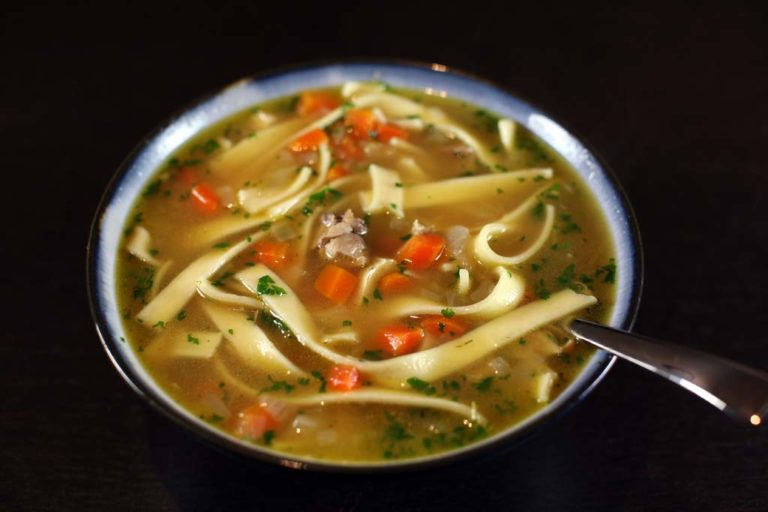
Chef's notes:
Chicken noodle soup is said to have curative properties. Chicken soup is the ultimate comfort food. But does it actually cure illness? Maybe, maybe not. But if you think about what you should be eating when you’re sick, you can’t do much better than chicken noodle soup. It has electrolytes, water, protein, carbohydrates, vitamins, and even fiber. It is essentially a balanced diet and really, really tasty, especially when you make it with homemade chicken stock. Read the article on how to make chicken stock if you have time.
Some form of chicken soup is eaten all over the world. Everyone does it a little differently. Even in the United States itself there are regional variations. This recipe is an extremely basic one that can be used as a base for the countless delicious and wonderful chicken soups that you will make. Have fun with this dish and see what you can come up with.
Ingredients
- 8 cups chicken stock
- 3 cups cooked chicken
- 2 cups diced carrot
- 2 cups diced onion
- 2 Tbsp butter
- ½ pound noodles
- 4 sprigs fresh parsley
- 1 sprig fresh thyme
- Salt
Homemade Chicken Noodle Soup Recipe, Cooked with Carrot, Onion, Chicken Stock, Egg Noodles, and Herbs
- Assemble the ingredients and prep them for the chicken noodle soup. For this soup I used all classic chicken noodle soup ingredients. They are listed to the right. The chicken stock I made the day before from a rooster I had. I roasted it and saved the meat for the soup while I used the bones and skin to make the stock. Also, the noodles are of a thick variety that seen to work better in soup.
- Cook the onions and carrots in butter. Melt the butter in a soup kettle or stock pot. Sweat the diced onions and carrots to soften them up and give them a head start in cooking. You aren’t trying to sauté them so much as just soften them. The technique is called sweating for the way the liquid is sweated out of the vegetables. After 10 minutes of sweating, move on.
- Pour the chicken stock over the onions and carrots. Add the chicken stock to the pot, and stir the mixture. You may notice that the onions are floating. As you continue cooking this soup, the onions will begin to sink. This means that they are done cooking, so don’t serve your soup until the onions are all cooked. You may even wait to cook the noodles until the onions are done.
- Add the diced chicken to the pot. It is preferable to use chicken that has already been cooked. If you only have raw chicken, just poach it first because putting raw chicken directly into your soup will create a lot of scum and floaters. It’s just coagulated blood and fat, but it doesn’t look very appetizing. To poach the chicken, drop it into some simmering liquid until it’s cooked. Then toss it in the soup.
- Finally, add the noodles to the simmering soup. Once you get the soup back up to a nice simmer, add the noodles, give it a quick stir, cover it, and get back to a simmer. As I mentioned before, I prefer the thicker noodles as they seem to hold up best in a soup. These noodles usually come in a bag. Of course, you could always make your own noodles, but that’s a horse of a different color.
Tips & Tricks
- As I have stressed previously, a homemade stock is going to make the difference between good and great soups. It really is easy. It just takes a few hours, but there is very little prep work involved. Just save your scraps from your regular cooking and make a stock on Saturday. Then you will have it to use for the whole week. Or you can freeze it for another time.
- If you have to use store-bought stock, at the very least do not use those wickedly salty little bouillon cubes or that paste. Buy whole, undiluted stock in a sealed container. But remember that you have absolutely no control over what they use to make that stuff. They take the idea behind using scraps to a whole other level.
- Broth is similar to stock except it usually is made with meat, and it is always seasoned and salted for ready consumption.
- A watched pot never boils over.
- Cool down large volumes of liquid by submerging them in ice-water baths and then stirring them.
